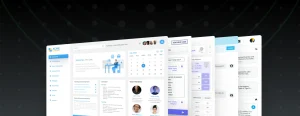AR is defined as digitally-driven information overlaid on top of real-world environments, in the form of filters – for instance, those used on Instagram or Snapchat, Facebook, or with the native AR ability of a smartphone – or with augmented reality games such as Pokemon GO; or with HUDs in cars that display the car’s speed and direction. Automotive HUDs, particularly in cars, is a popular application of AR.
Because of the natural immersiveness of VR – not to mention its tie‑ins to training, touring and gaming – this focus on business benefits is not hard to justify.
Augmented Reality
AR is a technology that augments physical reality objects with visual information generated by computers. The images of real-world objects (whether they are static images such as photos or dynamic images such as videos) are detected and tracked by AR with computer vision techniques such as visual odometry or images recognition. After the coordinates of real-world object images are calculated by the computer, the information is applied to render these virtual objects using VR computers in the right position and perspective relative to these real-world objects – the ultimate goal of AR is to create an illusion that these virtual items – such as virtual text on a signpost or a virtual map – are in the real world. AR can have many practical applications: various cars use AR in their HUDs (heads-up displays), where putting speed, directions and other data right in front of drivers’ eyes is safer than having to glance at a dashboard. Other consumer AR examples include virtual fitting rooms and furniture shows. AR is increasingly prevalent in the workplace: it can be used in manufacturing for examining tools and assessing production processes, or in medical practice for visualising operations or understanding how anatomy fits together during instruction or training sessions.
Virtual Reality
A computer-generated or virtual reality (VR) is a totally immersive digital experience. Users of VR are fully immersed into a digital world. People have long been using VR in entertainment settings like gaming automatically and thereafter, VR is being used in business applications at a fast pace. VR makes it possible for employees to learn how to operate a crane, or drive a truck, or cope with difficult customers in a way that even its traditional variant simply can’t. This means that our VR product ensures both better knowledge retention and real world performance than its traditional equivalent. VR can help users keep track of multifaceted systems by layering live images over whatever they’re looking at – like the veins of a person’s arm for blood draws, or mechanical parts as they come together in a mechanical environment. That way, users don’t have to stop what they’re doing to look back at video footage or a 2D diagram. As creativity specialists featuring in AR and VR become a more pressing priority, SMU offers an immersive new M.A. Creative Technology programme that combines creative disciplines like art and design with core digital technologies – apply now and dive in.
Mixed Reality
Here’s where the term ‘Mixed Reality’ can become useful for describing a mix of the so-called real, the augmented and the virtual that can offer advantages across many market sectors. It provides a new means of ‘attach[ing] the digital world to the real world’. MR lets designers and engineers manipulate their ideas directly with their own hands by manipulating 3D models It is an indicator that IKEA recently released a concept kitchen table that shows recipes when placed on it and recognises the ingredients you have on the table by suggesting recipes based on your contents. MR technology has a number of applications in the retail, healthcare and education sectors. For example, students could use MR for simulated patients during surgery operations (via using simulation software). This has a number of advantages; reducing the risks and expenses of actual training while increasing the retention of different aspects of the practical work. It therefore helps improve the efficiency of the assembly lines, since the MR’d workers could follow information in real-time (holographic technology). One of the greatest challenges posed by MR is the need to seamlessly merge real and simulated worlds. To do this, MR must minimise latency and accelerate data transmission between the user’s device and the digital environment.
Artificial Intelligence
Artificial Intelligence has been one of the most prolifically discussed technologies in recent years. AI is at the heart of our Augmented and Virtual Reality apps. Whether it’s providing customised, contextualised information and engagement for consumers, speeding up innovation across industry sectors or reimagining how basic work gets done, AI promises to create increasingly better experiences for users. Augmented reality super-imposes virtual content onto the user’s physical surroundings, whereas virtual reality completely immerses the recipient into an artificial world. AR can be used for anything from furniture stores that project 3D images of products onto homes to help consumers decide whether they like them to neurosurgeons that use an AR brain scan to guide their surgery, or TV stations that super-impose virtual 1st ten lines during NFL games. Businesses are clamouring for individuals with the skills to build and deliver AR and VR infrastructure and solutions. The SMU Master of Arts in Creative Technology is ideal for those who wish to apply creative and design skillsets to core and emerging technologies.






More Stories
Low-Code/No-Code: Your Shortcut to Smarter, Faster Business Tools
Decentralized Physical Infrastructure Networks (DePIN): The Quiet Revolution in Real-World Services
Tech Career Paths for Non-Programming Professionals